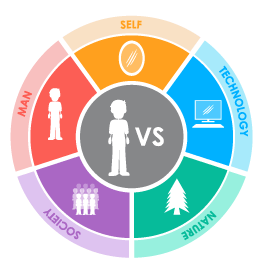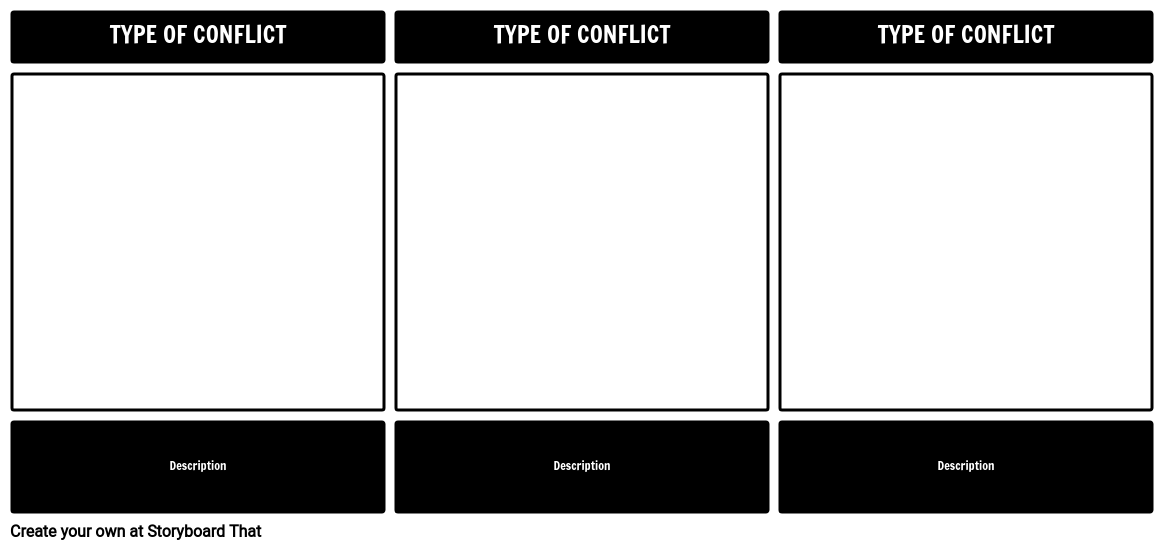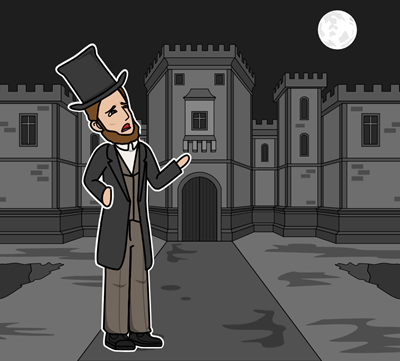Lesson Plan Overview
Storyboarding is an excellent way to focus on types of literary conflicts.
Having students create storyboards that show the cause and effect of different types of conflicts strengthens analytical thinking about literary concepts. Have your students choose an example of each literary conflict and depict them using the storyboard creator. In the storyboard, an example of each conflict should be visually represented, along with an explanation of the scene, and how it fits the particular category of conflict.
Examples of Literary Conflict in A Tale of Two Cities
MAN vs. MAN
Madame Defarge doesn’t just seek revenge on Charles and his uncle and father; she also wishes to make sure that his wife and daughter are eliminated. She takes a gun and goes to their lodging in Paris, but Miss Pross is the only one there. Miss Pross keeps Mme. Defarge from opening a door in the house, so Mme. Defarge attacks her. When she reaches into her dress and pulls out a gun, Miss Pross grabs her wrist and the gun goes off, killing Mme. Defarge.
MAN vs. SELF
Sydney Carton is a lonely, unhappy man who seems to be in a deep depression about his life and what could have been different. He bears a strong resemblance to Charles Darnay, and often wistfully compares himself to Charles’ successes. He believes that Lucie could make him whole, but she does not love him the way that he loves her. He swears he will do anything for her or for those dear to her, a promise which he fulfills when he sacrifices his life for Charles.
MAN vs. SOCIETY
Charles Darnay was taken away from his father by his mother many years before because of the atrocities his father and uncle committed. He maintains as he gets older that his family name is a source of shame, and he renounces it and his inheritance to his uncle later on. However, he is still a member of the aristocracy in the French peasants’ eyes, and there is no place for him to return when he comes back to try to save Gabelle. While he is accepted in England, his family’s crimes cannot be forgiven in France.
Template and Class Instructions
(These instructions are completely customizable. After clicking "Copy Activity", update the instructions on the Edit Tab of the assignment.)
Student Instructions
Create a storyboard that shows at least three forms of literary conflict in A Tale of Two Cities.
- Identify conflicts in A Tale of Two Cities.
- Categorize each conflict as Character vs. Character, Character vs. Self, Character vs. Society, Character vs. Nature, or Character vs. Technology.
- Illustrate conflicts in the cells, using characters from the story.
- Write a short description of the conflict below the cell.
Lesson Plan Reference
Student Rubric
(You can also create your own on Quick Rubric.)
| Proficient | Emerging | Beginning | Try Again | |
|---|---|---|---|---|
| Conflict Identification | Student identifies correct major conflicts and uses strong, clear textual evidence to support choice. | Student identifies correct major conflict and uses few or unclear details to support their choice. | Student identifies incorrect major conflict, and uses some details from the text to support their choice. | Student does not attempt to identify major conflict or identifies incorrect major conflict with no explanation. |
| Understanding Outcome | Student clearly shows the outcome of the conflict and its effects on the protagonist with evidence from the text. | Student shows the outcome of the conflict and its effect on the protagonist, but some evidence is unclear. | Student shows the outcome of the conflict, but does not examine its effect on the protagonist and uses some vague textual evidence. | Student does not clearly show the outcome of the conflict or use textual evidence. |
| Character | Storyboard includes all required characters and clearly names them. Goes above and beyond by adding additional details. | Storyboard includes all required characters and clearly names them. | Storyboard includes protagonist and antagonist but leaves out other required characters. | Storyboard does not include the names of required characters. |
| Storyboard | Student clearly shows effort to convey the setting the scene of the book | Student attempts to convey setting and scene of the book, but lacks some clarity. | Student does not clearly convey the setting and scene. | Student makes little or no attempt to convey the setting or scene. |
| Spelling and Grammar | Student uses exemplary spelling and grammar. There are no errors. | Student makes a minor error in spelling and grammar. | Student makes several minor errors in spelling and grammar. | Student makes many errors in spelling and grammar; little attempt at spellchecking. |
Lesson Plan Overview
Storyboarding is an excellent way to focus on types of literary conflicts.
Having students create storyboards that show the cause and effect of different types of conflicts strengthens analytical thinking about literary concepts. Have your students choose an example of each literary conflict and depict them using the storyboard creator. In the storyboard, an example of each conflict should be visually represented, along with an explanation of the scene, and how it fits the particular category of conflict.
Examples of Literary Conflict in A Tale of Two Cities
MAN vs. MAN
Madame Defarge doesn’t just seek revenge on Charles and his uncle and father; she also wishes to make sure that his wife and daughter are eliminated. She takes a gun and goes to their lodging in Paris, but Miss Pross is the only one there. Miss Pross keeps Mme. Defarge from opening a door in the house, so Mme. Defarge attacks her. When she reaches into her dress and pulls out a gun, Miss Pross grabs her wrist and the gun goes off, killing Mme. Defarge.
MAN vs. SELF
Sydney Carton is a lonely, unhappy man who seems to be in a deep depression about his life and what could have been different. He bears a strong resemblance to Charles Darnay, and often wistfully compares himself to Charles’ successes. He believes that Lucie could make him whole, but she does not love him the way that he loves her. He swears he will do anything for her or for those dear to her, a promise which he fulfills when he sacrifices his life for Charles.
MAN vs. SOCIETY
Charles Darnay was taken away from his father by his mother many years before because of the atrocities his father and uncle committed. He maintains as he gets older that his family name is a source of shame, and he renounces it and his inheritance to his uncle later on. However, he is still a member of the aristocracy in the French peasants’ eyes, and there is no place for him to return when he comes back to try to save Gabelle. While he is accepted in England, his family’s crimes cannot be forgiven in France.
Template and Class Instructions
(These instructions are completely customizable. After clicking "Copy Activity", update the instructions on the Edit Tab of the assignment.)
Student Instructions
Create a storyboard that shows at least three forms of literary conflict in A Tale of Two Cities.
- Identify conflicts in A Tale of Two Cities.
- Categorize each conflict as Character vs. Character, Character vs. Self, Character vs. Society, Character vs. Nature, or Character vs. Technology.
- Illustrate conflicts in the cells, using characters from the story.
- Write a short description of the conflict below the cell.
Lesson Plan Reference
Student Rubric
(You can also create your own on Quick Rubric.)
| Proficient | Emerging | Beginning | Try Again | |
|---|---|---|---|---|
| Conflict Identification | Student identifies correct major conflicts and uses strong, clear textual evidence to support choice. | Student identifies correct major conflict and uses few or unclear details to support their choice. | Student identifies incorrect major conflict, and uses some details from the text to support their choice. | Student does not attempt to identify major conflict or identifies incorrect major conflict with no explanation. |
| Understanding Outcome | Student clearly shows the outcome of the conflict and its effects on the protagonist with evidence from the text. | Student shows the outcome of the conflict and its effect on the protagonist, but some evidence is unclear. | Student shows the outcome of the conflict, but does not examine its effect on the protagonist and uses some vague textual evidence. | Student does not clearly show the outcome of the conflict or use textual evidence. |
| Character | Storyboard includes all required characters and clearly names them. Goes above and beyond by adding additional details. | Storyboard includes all required characters and clearly names them. | Storyboard includes protagonist and antagonist but leaves out other required characters. | Storyboard does not include the names of required characters. |
| Storyboard | Student clearly shows effort to convey the setting the scene of the book | Student attempts to convey setting and scene of the book, but lacks some clarity. | Student does not clearly convey the setting and scene. | Student makes little or no attempt to convey the setting or scene. |
| Spelling and Grammar | Student uses exemplary spelling and grammar. There are no errors. | Student makes a minor error in spelling and grammar. | Student makes several minor errors in spelling and grammar. | Student makes many errors in spelling and grammar; little attempt at spellchecking. |
How Tos about Identifying Literary Conflict in A Tale of Two Cities
Engage students with a classroom debate on literary conflict
Organizing a debate allows students to actively discuss and defend their interpretations of literary conflict, deepening their understanding through collaborative learning and critical thinking.
Assign debate teams based on conflict types
Divide your class into small groups, each representing a different type of conflict from the novel. This encourages focused research and gives every student a role in the discussion.
Challenge teams to find textual evidence
Direct each team to locate quotes or passages that best illustrate their assigned conflict. Using specific examples helps students support their arguments with textual proof.
Host the debate and set clear rules
Facilitate a respectful, timed debate where teams present their evidence and respond to questions. This structure keeps the activity organized and equitable for all voices.
Reflect as a class on key insights
Lead a brief discussion after the debate, encouraging students to share what they learned about literary conflict and how their perspectives changed. Reflection deepens understanding and connects debate skills to literary analysis.
Frequently Asked Questions about Identifying Literary Conflict in A Tale of Two Cities
What types of literary conflict are found in A Tale of Two Cities?
A Tale of Two Cities features several types of literary conflict, including man vs. man (e.g., Madame Defarge vs. Miss Pross), man vs. self (Sydney Carton's internal struggles), and man vs. society (Charles Darnay vs. the French Revolution). These conflicts drive the plot and develop the themes of the novel.
How can I teach literary conflict using storyboards for A Tale of Two Cities?
Have students select examples of different types of conflict from the novel and visually represent them using a storyboard creator. Each cell should illustrate the conflict, identify the type (e.g., character vs. character), and include a brief explanation. This helps students analyze cause and effect and deepens understanding.
What is an example of man vs. self conflict in A Tale of Two Cities?
Sydney Carton represents man vs. self conflict as he battles feelings of worthlessness and regret. His internal struggle culminates in his decision to sacrifice himself for Charles Darnay, fulfilling his promise to Lucie Manette.
Why is identifying conflict important when studying A Tale of Two Cities?
Identifying conflict helps students understand character motivations, plot development, and themes. In A Tale of Two Cities, conflicts reveal the complexities of revolution, personal sacrifice, and justice, deepening literary analysis skills.
What are some storyboard activity ideas for analyzing conflict in literature?
Ask students to create storyboards showing scenes of conflict, categorize each as character vs. character, self, or society, and write brief descriptions. This visual approach reinforces comprehension and analytical thinking.
More Storyboard That Activities
A Tale of Two Cities
Testimonials

“By using the product, they were so excited and they learned so much...”–K-5 Librarian and Instructinal Technology Teacher

“I'm doing a Napoleon timeline and I'm having [students] determine whether or not Napoleon was a good guy or a bad guy or somewhere in between.”–History and Special Ed Teacher

“Students get to be creative with Storyboard That and there's so many visuals for them to pick from... It makes it really accessible for all students in the class.”–Third Grade Teacher
© 2026 - Clever Prototypes, LLC - All rights reserved.
StoryboardThat is a trademark of Clever Prototypes, LLC, and Registered in U.S. Patent and Trademark Office








